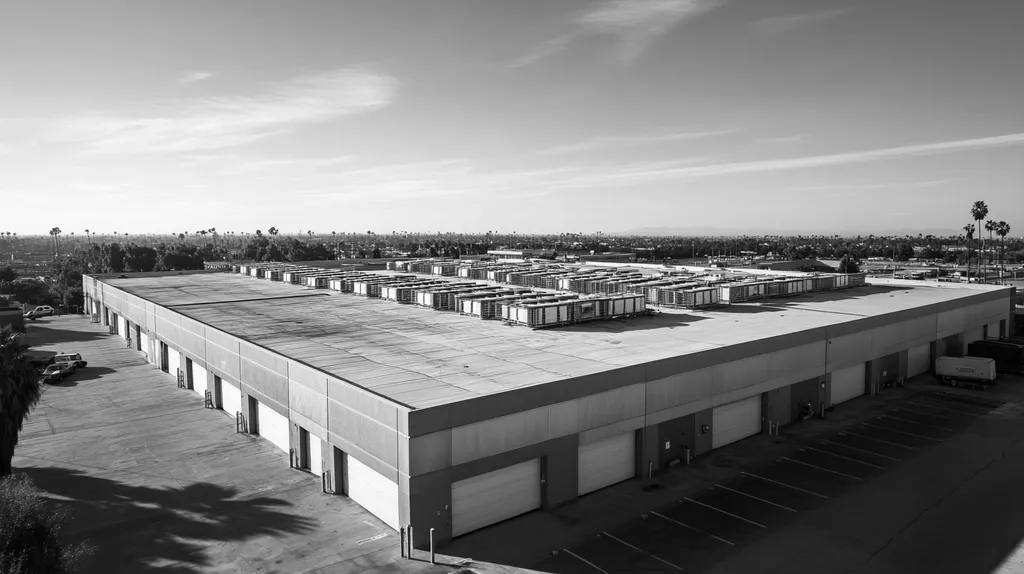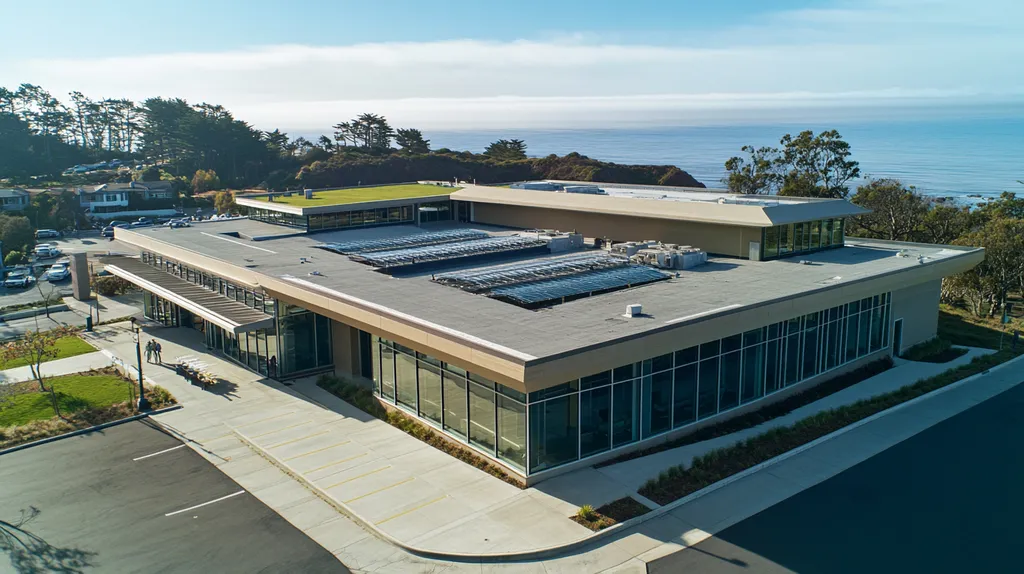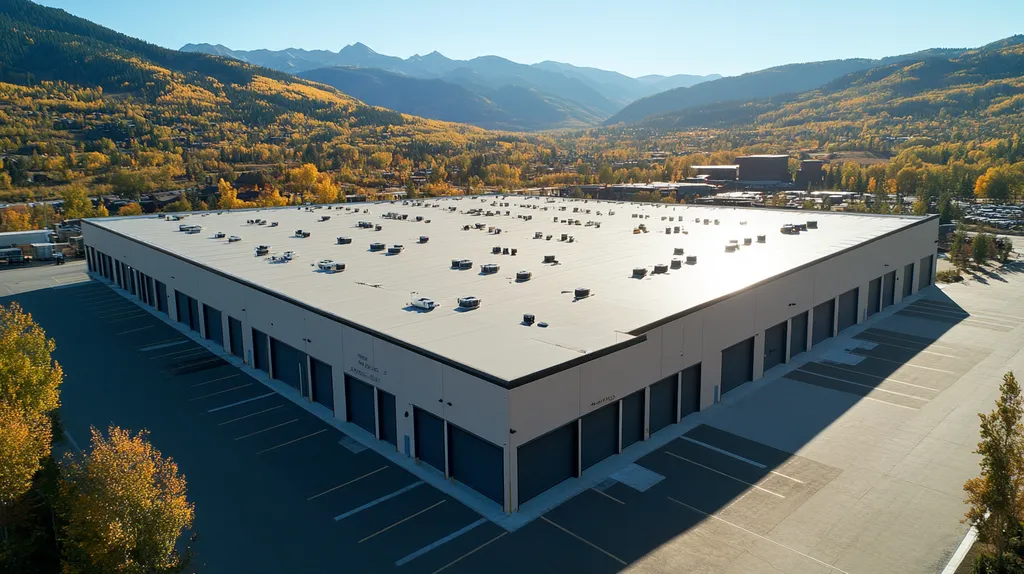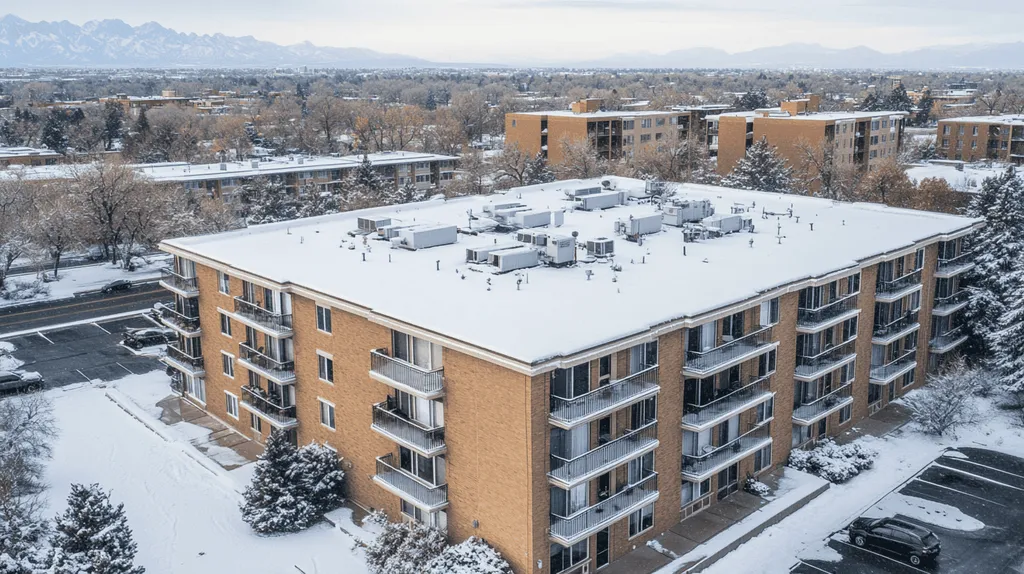Welcome to today’s Battle Royale featuring two roofing heavyweights: “Sloped Roofs” in the east corner versus “Flat Roofs” in the west!
Tonight’s showdown pits these contenders against each other across six punishing rounds designed to test every aspect of their performance for Commercial Roof Ventilation.
At stake? Millions in potential costs, decades of building protection, and the critical performance demands of modern commercial and industrial facilities.
Our professional judging panel will evaluate each round on technical merit, real-world performance, and value delivery. After all six rounds, we’ll declare our ultimate champion.
Ladies and gentlemen, facility managers and building owners… it’s time to rumble!
ROUND 1: INITIAL COSTS & INSTALLATION
In the high-stakes world of commercial roofing, initial costs and installation decisions can make or break a project’s success. With average commercial roof installations ranging from $150,000 to over $1 million, the shape of your roof isn’t just an aesthetic choice – it’s a major financial commitment that impacts everything from materials to timeline.
Material Expenses
Sloped commercial roofs typically require premium materials like architectural shingles, metal panels, or clay tiles. These materials often cost 30-40% more per square foot than flat roof alternatives but offer superior weather resistance and longer lifespans.
Flat roof systems utilize more economical materials such as TPO, EPDM, or modified bitumen membranes. While these materials cost less initially, they may require more frequent maintenance and earlier replacement.
The material requirements for ventilation systems also vary significantly. Sloped roofs need ridge vents, soffit systems, and specialized flashings, while flat roofs can utilize simpler through-roof ventilation solutions.
For pure material costs, flat roofs earn the “ADVANTAGE” due to lower upfront expenses and simpler ventilation components.
Installation Complexity
Sloped commercial roofs demand specialized equipment, safety systems, and highly skilled labor teams. The angles involved create challenges for material handling and increase worker fatigue, leading to longer installation times.
Opening up existing vent points in flat roofs allows crews to work more efficiently with better access and fewer safety constraints. This approach reduces installation resistance and speeds up the overall process. (source: Adapt Overcome Training)
Flat roof installation also requires fewer specialized tools and allows for more straightforward material staging and workflow patterns.
Due to simpler installation requirements and better worker efficiency, flat roofs claim the “ADVANTAGE” in this category.
Project Timeline
Sloped roof installations typically take 25-40% longer than comparable flat roof projects. This extended timeline increases labor costs and prolongs business disruption for building occupants.
Weather delays impact sloped installations more severely, as steep pitches make work impossible during even light precipitation. Each delay cascades into schedule overruns and coordination headaches.
Flat roof installations proceed more predictably, with fewer weather-related delays and more consistent daily progress. This predictability allows for better resource allocation and project planning.
The faster, more predictable installation process gives flat roofs the clear “ADVANTAGE” for project timeline considerations.
ROUND 1 WINNER: FLAT ROOFS
ROUND 2: DURABILITY & LIFESPAN
When it comes to commercial roofing, durability and lifespan aren’t just technical specifications – they’re make-or-break factors that determine whether your investment soars or sinks. With replacement costs running into six or seven figures, the stakes couldn’t be higher. The shape of your roof plays a pivotal role in how long it will protect your building and how well it stands up to Mother Nature’s worst tantrums.
Weather Resistance
Sloped roofs excel at shedding water, snow, and debris through the magic of gravity. Their angled design prevents pooling water – public enemy #1 for roof deterioration – and reduces the impact of UV radiation by dispersing it across a larger surface area.
Flat roofs, despite modern drainage systems, remain vulnerable to ponding water and snow accumulation. Even minor settling can create low spots that trap moisture, accelerating membrane degradation and increasing the risk of leaks.
The superior water-shedding capabilities and reduced exposure to standing moisture give sloped roofs the clear “ADVANTAGE” in weather resistance.
Material Longevity
Sloped commercial roofs typically employ materials engineered for decades of performance. Metal panels can last 50+ years, while premium tile systems often survive 30-40 years before needing replacement. The steep angle also reduces direct sun exposure, helping materials maintain their protective properties longer.
Flat roof membranes, while technologically advanced, typically require replacement every 15-25 years. Their horizontal orientation maximizes UV exposure and thermal stress, accelerating material breakdown even with regular maintenance.
The dramatic difference in material lifespan and environmental resilience gives sloped roofs the “ADVANTAGE” for longevity.
Maintenance Requirements
Sloped roofs require less frequent maintenance due to their self-cleaning properties and durable materials. The angle helps wash away dirt and debris, while inspection points are typically concentrated at predictable locations like valleys and ridges.
Flat roofs demand vigilant maintenance to prevent problems. Drains and scuppers need regular cleaning, seams require frequent inspection, and the entire surface must be monitored for signs of ponding or membrane damage.
The right roof design combines scientific understanding with practical considerations, ensuring both durability and reduced maintenance needs over time. (source: Mikku and Sons)
With lower maintenance demands and fewer inspection requirements, sloped roofs claim the “ADVANTAGE” in maintenance.
ROUND 2 WINNER: Sloped Roofs
ROUND 3: PERFORMANCE FACTORS
In the high-stakes world of commercial roofing, performance factors can mean the difference between a building that thrives and one that fails. With energy costs soaring and climate challenges intensifying, how your roof handles ventilation, moisture, and temperature control isn’t just about comfort – it’s about survival. Today’s property managers face critical decisions that impact decades of building performance and millions in operating costs.
Ventilation Efficiency
Proper ventilation isn’t just about moving air – it’s about creating a sustainable environment that protects your entire building envelope. A well-ventilated roof system can reduce cooling costs by up to 30% and extend material lifespan by preventing moisture accumulation.
Sloped roofs leverage thermal dynamics to create natural airflow patterns, pulling cool air in through soffits and exhausting hot air at the ridge. This passive ventilation system works 24/7 without mechanical assistance or energy consumption.
Flat roofs require engineered solutions like mechanical ventilators and exhaust fans to achieve similar results. Any failure in these systems can lead to rapid heat buildup and accelerated material degradation.
The natural airflow advantage and reduced mechanical dependency give sloped roofs the clear “ADVANTAGE” in ventilation efficiency.
Moisture Management
Moisture is the silent killer of commercial roofs, causing billions in damage annually through condensation, leaks, and structural deterioration. Effective moisture management requires both prevention and removal strategies.
Sloped roofs excel at moisture management through gravity-assisted drainage and natural airflow patterns. Their design actively prevents water accumulation and accelerates drying after precipitation events.
Any roof with compromised ventilation poses significant risks during maintenance and repair operations, regardless of its shape or material composition. (source: Adapt Overcome Training)
While flat roofs can manage moisture through proper drainage design, they remain vulnerable to ponding water and ice damming. These issues demand constant monitoring and intervention.
For superior passive moisture control and reduced intervention requirements, sloped roofs claim the “ADVANTAGE” in this category.
Energy Efficiency
In an era of rising energy costs, roof design can make or break your building’s energy performance. Smart ventilation strategies don’t just control temperature – they dramatically impact HVAC loads and operating expenses.
Sloped roofs create an insulating air barrier between the roof deck and interior space. This natural buffer zone reduces heat transfer and moderates temperature swings, leading to more consistent indoor conditions.
Flat roofs absorb and transfer more solar heat directly into the building envelope. Even with modern insulation systems, they typically require more energy input to maintain comfortable interior temperatures.
Based on superior thermal performance and reduced HVAC demands, sloped roofs take the “ADVANTAGE” in energy efficiency.
ROUND 3 WINNER: Sloped Roofs
ROUND 4: MAINTENANCE REQUIREMENTS
In the high-stakes arena of commercial roofing, maintenance isn’t just a checkbox – it’s the difference between a roof that lasts 30 years and one that fails catastrophically at year 10. With replacement costs routinely exceeding $500,000, smart maintenance strategies can save property owners millions over a building’s lifetime. Yet too many facilities waste money on reactive repairs while ignoring the fundamental ways roof shape impacts maintenance needs.
Maintenance Accessibility
Sloped commercial roofs present significant accessibility challenges that impact both inspection frequency and repair costs. Their steep angles require specialized safety equipment, limiting when and how maintenance teams can access problem areas.
Vertical ventilation work on sloped roofs demands extra precautions and specialized training to safely release heat and gases during maintenance operations. (source: Adapt Overcome Training)
Flat roofs offer superior accessibility with minimal safety equipment requirements. Their level surface allows maintenance teams to move freely, inspect thoroughly, and complete repairs efficiently.
The safer, simpler access and reduced equipment needs give flat roofs the clear “ADVANTAGE” in maintenance accessibility.
Inspection Requirements
Sloped roofs benefit from natural drainage that reduces inspection frequency. Their angled design actively prevents water accumulation, minimizing the risk of hidden damage between scheduled checks.
Critical inspection points on sloped roofs cluster predictably around valleys, ridges, and penetrations. This concentration allows maintenance teams to focus their attention on known vulnerability zones.
Flat roofs demand constant vigilance against ponding water and debris accumulation. Their horizontal surface requires thorough inspection of the entire roof area to catch developing issues before they cause damage.
With reduced inspection frequency and focused problem areas, sloped roofs claim the “ADVANTAGE” in inspection requirements.
Repair Complexity
Sloped roof repairs often involve complex logistics and specialized materials. Their steep angles complicate everything from material staging to worker positioning, driving up repair costs and extending project timelines.
Weather conditions severely restrict repair windows on sloped surfaces. Even light precipitation can make work unsafe, leading to costly delays and leaving buildings vulnerable to additional damage.
Flat roof repairs proceed more efficiently with better working conditions and simpler material handling. Their level surface allows crews to complete repairs quickly with standard tools and techniques.
Based on simpler logistics and more flexible repair conditions, flat roofs take the “ADVANTAGE” in repair complexity.
ROUND 4 WINNER: TIE
ROUND 5: SUSTAINABILITY CREDENTIALS
In today’s climate-conscious market, roofing decisions carry massive environmental implications. With buildings accounting for nearly 40% of global carbon emissions and landfills choking on construction waste, choosing between sloped and flat commercial roofs isn’t just about protecting assets – it’s about protecting our planet’s future. A single large commercial roof replacement can generate up to 10 tons of waste material.
Materials and Resource Efficiency
Sloped commercial roofs typically utilize highly recyclable materials like metal panels and concrete tiles. These materials not only offer lifespans exceeding 50 years but can be almost entirely recycled at end-of-life, dramatically reducing landfill impact.
The angle of sloped roofs also reduces material stress and UV exposure, helping components maintain their protective properties longer. This extended durability means fewer replacement cycles and less overall resource consumption.
Flat roof systems rely heavily on petroleum-based membranes with shorter lifecycles and limited recycling potential. Even with proper maintenance, these materials typically require replacement every 15-20 years, generating significant waste.
For superior material longevity and recyclability, sloped roofs claim the “ADVANTAGE” in resource efficiency.
Energy Performance and Climate Resilience
Sloped roofs create natural ventilation channels that help regulate building temperature. Their design promotes passive cooling through stack effect, reducing HVAC energy demands during peak cooling seasons.
The additional air space beneath sloped roofs acts as a thermal buffer, moderating temperature swings and reducing heat transfer into occupied spaces. This natural insulation can cut cooling costs by up to 25% compared to poorly ventilated systems.
Flat roofs absorb and transfer more direct solar radiation, increasing cooling loads and energy consumption. Their horizontal surface maximizes heat gain, forcing HVAC systems to work harder and consume more energy.
Based on superior passive cooling and reduced energy demands, sloped roofs take the “ADVANTAGE” in energy performance.
Environmental Impact and Waste Management
Vertical ventilation strategies in sloped roofs provide natural pathways for heat and gas release, reducing reliance on mechanical systems that consume energy and require frequent maintenance. (source: Adapt Overcome Training)
Sloped designs also excel at managing stormwater runoff, preventing the pooling and erosion issues that plague flat surfaces. This natural drainage reduces the need for chemical treatments and minimizes water damage to roofing materials.
Flat roofs often require extensive drainage systems and regular maintenance to prevent water accumulation. Their design can lead to premature material failure and increased chemical treatment needs, generating both physical waste and environmental toxins.
For reduced environmental impact and better waste prevention, sloped roofs secure the “ADVANTAGE” in this category.
ROUND 5 WINNER: Sloped Roofs
ROUND 6: SPECIALIZED APPLICATIONS
In today’s demanding commercial environment, specialized roofing applications can make or break a building’s performance. With energy costs averaging $2.50 per square foot annually in commercial spaces, every ventilation decision carries massive financial implications. Yet too many property managers overlook how roof shape fundamentally impacts specialized building systems and operational efficiency.
Insulation and Energy Efficiency
Modern commercial buildings demand sophisticated insulation strategies to combat rising energy costs. The stakes are particularly high in climate-controlled facilities, where poor insulation can inflate HVAC expenses by up to 40%.
Sloped roofs create natural air chambers that enhance insulation performance. Their design allows for deeper insulation layers while maintaining crucial ventilation pathways that prevent moisture buildup and thermal bridging.
Flat roofs struggle to balance insulation depth with drainage requirements. Even minor compromises in insulation coverage can create hot spots that overwork HVAC systems and drive up operating costs.
Given their superior insulation flexibility and natural thermal barriers, sloped roofs claim the “ADVANTAGE” in this category.
Water Management and Drainage
Proper water management isn’t just about preventing leaks – it’s about protecting millions in building assets and operations. A single major water intrusion event can shut down operations for weeks and trigger catastrophic repair costs.
Sloped roofs excel at passive water management through gravity-assisted drainage. Their design actively prevents ponding while channeling water away from vulnerable areas like penetrations and transitions.
Flat roofs require complex drainage systems that demand constant maintenance and monitoring. Even minor drain blockages can create dangerous ponding conditions that accelerate material degradation.
For superior passive drainage and reduced system complexity, sloped roofs secure the “ADVANTAGE” in water management.
HVAC Integration and Space Utilization
Vertical ventilation through commercial roofs isn’t just about moving air – it’s about safely releasing heat and gases while maintaining structural integrity. The wrong configuration can create dangerous conditions during maintenance or emergency operations.
Sloped roofs provide natural channels for vertical ventilation, working with physics instead of against it. Their design helps dissipate heat and gases more effectively while reducing stress on mechanical systems.
Flat roofs often require more aggressive mechanical ventilation to achieve similar results. This increased equipment density can create maintenance challenges and accelerate surface wear.
Vertical ventilation work carries significant risks regardless of roof shape, demanding careful planning and proper technique for safe operations. (source: Adapt Overcome Training)
With better natural ventilation and reduced mechanical requirements, sloped roofs take the “ADVANTAGE” in HVAC integration.
ROUND 6 WINNER: Sloped Roofs
AND THE WINNER IS…
After six grueling rounds of technical evaluation, we have our verdict, and it’s a decisive victory for SLOPED ROOFS with an impressive 4-1-1 record!
The champion dominated in critical categories including durability, performance, and sustainability. Its natural ventilation prowess, superior weather resistance, and impressive 50+ year material lifespan proved too powerful for the competition to overcome.
But don’t count flat roofs out entirely! In facilities requiring maximum rooftop equipment access or facing strict height restrictions, flat roofs still deliver a solid performance advantage. Their lower initial costs and simpler installation requirements also make them contenders for budget-conscious projects.
IMPORTANT NOTICE: While this analysis reflects general industry patterns, every building faces unique challenges. Local climate conditions, structural requirements, and specific facility needs can significantly impact roofing decisions. Property owners should always consult qualified roofing professionals who can evaluate their particular situation before making final selections.
Ladies and gentlemen, in the high-stakes world of commercial roofing, success isn’t about following the crowd – it’s about matching your specific building’s needs with the right roofing system’s strengths. Choose wisely, and may your ventilation always be victorious!
FREQUENTLY ASKED QUESTIONS
Q. What are the initial costs for a commercial roof installation?
A. Initial costs for commercial roof installations can skyrocket, ranging from $150,000 to over $1 million. The shape of your roof affects everything from material selection to installation complexity, making this decision crucial. If you skimp on quality to save upfront, you might end up with an expensive mess later.
Q. How does roof shape affect durability and lifespan of an industrial roof?
A. The shape of your roof significantly influences its durability and lifespan. Sloped roofs shed water and snow, preventing pooling and premature failure, while flat roofs are prone to traps that accelerate deterioration. Choosing wisely can save you from an early roof burial.
Q. What are the ventilation efficiency differences between flat and sloped roofs?
A. Sloped roofs excel in ventilation efficiency due to natural airflow patterns that promote cooling. They harness the power of thermodynamics, unlike flat roofs that need mechanical support for similar results. If you want air to flow, gravity is your best friend here.
Q. How do maintenance requirements differ between sloped and flat commercial roofs?
A. Sloped roofs typically require less frequent maintenance thanks to their self-cleaning properties and predictable inspection points. Meanwhile, flat roofs demand constant vigilance to catch issues before they spiral out of control. You wouldn’t want to gamble with roof repairs, would you?
Q. Which roof shape is better for sustainability in commercial buildings?
A. Sloped roofs outshine flat roofs when it comes to sustainability. They use recyclable materials and have longer lifespans, dramatically reducing landfill impact. If you’re serious about the planet, investing in the right roof shape is a no-brainer.
Q. How does roofing shape influence HVAC system efficiency?
A. The roof shape affects how HVAC systems perform, especially in terms of insulation and ventilation. Sloped roofs provide better natural airflow and insulation, reducing energy costs. Flat roofs often require additional mechanical support, which can lead to higher operating expenses. Who wants that extra heat in their wallet?
Q. What specialized applications should I consider for my commercial roof?
A. Specialized applications, such as green roofs or integrated HVAC systems, vary with roof shape. Sloped roofs facilitate better water management and natural ventilation, while flat roofs might struggle. For optimization, choose a design that supports your specific operational needs without compromising efficiency.











